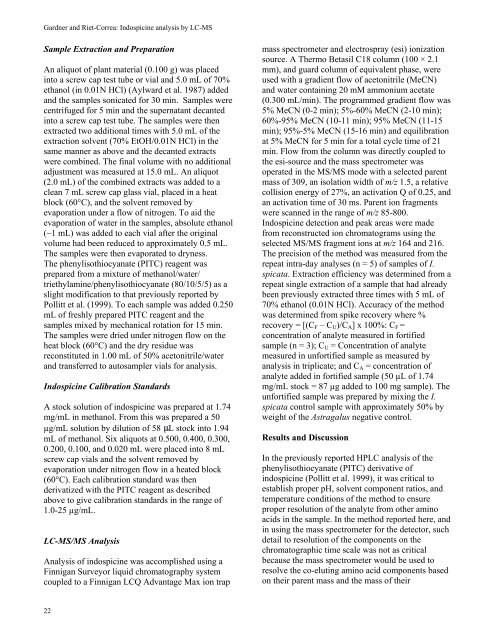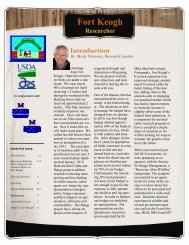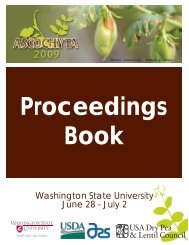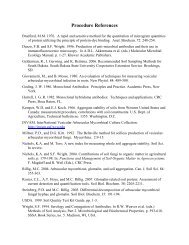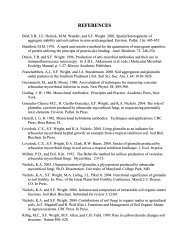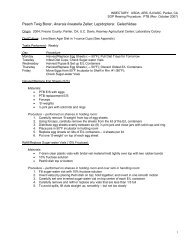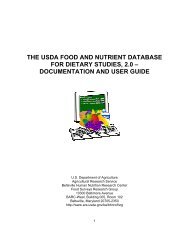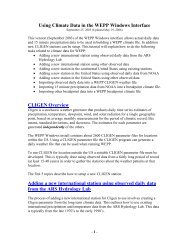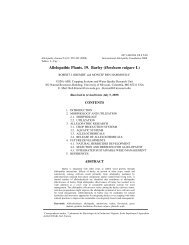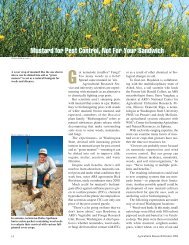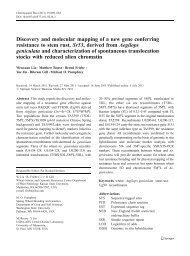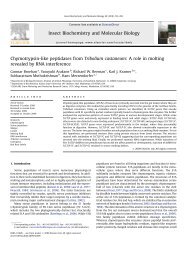International Journal of Poisonous Plant Research - Agricultural ...
International Journal of Poisonous Plant Research - Agricultural ...
International Journal of Poisonous Plant Research - Agricultural ...
You also want an ePaper? Increase the reach of your titles
YUMPU automatically turns print PDFs into web optimized ePapers that Google loves.
Gardner and Riet-Correa: Indospicine analysis by LC-MS<br />
Sample Extraction and Preparation<br />
An aliquot <strong>of</strong> plant material (0.100 g) was placed<br />
into a screw cap test tube or vial and 5.0 mL <strong>of</strong> 70%<br />
ethanol (in 0.01N HCl) (Aylward et al. 1987) added<br />
and the samples sonicated for 30 min. Samples were<br />
centrifuged for 5 min and the supernatant decanted<br />
into a screw cap test tube. The samples were then<br />
extracted two additional times with 5.0 mL <strong>of</strong> the<br />
extraction solvent (70% EtOH/0.01N HCl) in the<br />
same manner as above and the decanted extracts<br />
were combined. The final volume with no additional<br />
adjustment was measured at 15.0 mL. An aliquot<br />
(2.0 mL) <strong>of</strong> the combined extracts was added to a<br />
clean 7 mL screw cap glass vial, placed in a heat<br />
block (60°C), and the solvent removed by<br />
evaporation under a flow <strong>of</strong> nitrogen. To aid the<br />
evaporation <strong>of</strong> water in the samples, absolute ethanol<br />
(~1 mL) was added to each vial after the original<br />
volume had been reduced to approximately 0.5 mL.<br />
The samples were then evaporated to dryness.<br />
The phenylisothiocyanate (PITC) reagent was<br />
prepared from a mixture <strong>of</strong> methanol/water/<br />
triethylamine/phenylisothiocyanate (80/10/5/5) as a<br />
slight modification to that previously reported by<br />
Pollitt et al. (1999). To each sample was added 0.250<br />
mL <strong>of</strong> freshly prepared PITC reagent and the<br />
samples mixed by mechanical rotation for 15 min.<br />
The samples were dried under nitrogen flow on the<br />
heat block (60°C) and the dry residue was<br />
reconstituted in 1.00 mL <strong>of</strong> 50% acetonitrile/water<br />
and transferred to autosampler vials for analysis.<br />
Indospicine Calibration Standards<br />
A stock solution <strong>of</strong> indospicine was prepared at 1.74<br />
mg/mL in methanol. From this was prepared a 50<br />
µg/mL solution by dilution <strong>of</strong> 58 L stock into 1.94<br />
mL <strong>of</strong> methanol. Six aliquots at 0.500, 0.400, 0.300,<br />
0.200, 0.100, and 0.020 mL were placed into 8 mL<br />
screw cap vials and the solvent removed by<br />
evaporation under nitrogen flow in a heated block<br />
(60°C). Each calibration standard was then<br />
derivatized with the PITC reagent as described<br />
above to give calibration standards in the range <strong>of</strong><br />
1.0-25 µg/mL.<br />
LC-MS/MS Analysis<br />
Analysis <strong>of</strong> indospicine was accomplished using a<br />
Finnigan Surveyor liquid chromatography system<br />
coupled to a Finnigan LCQ Advantage Max ion trap<br />
22<br />
mass spectrometer and electrospray (esi) ionization<br />
source. A Thermo Betasil C18 column (100 × 2.1<br />
mm), and guard column <strong>of</strong> equivalent phase, were<br />
used with a gradient flow <strong>of</strong> acetonitrile (MeCN)<br />
and water containing 20 mM ammonium acetate<br />
(0.300 mL/min). The programmed gradient flow was<br />
5% MeCN (0-2 min); 5%-60% MeCN (2-10 min);<br />
60%-95% MeCN (10-11 min); 95% MeCN (11-15<br />
min); 95%-5% MeCN (15-16 min) and equilibration<br />
at 5% MeCN for 5 min for a total cycle time <strong>of</strong> 21<br />
min. Flow from the column was directly coupled to<br />
the esi-source and the mass spectrometer was<br />
operated in the MS/MS mode with a selected parent<br />
mass <strong>of</strong> 309, an isolation width <strong>of</strong> m/z 1.5, a relative<br />
collision energy <strong>of</strong> 27%, an activation Q <strong>of</strong> 0.25, and<br />
an activation time <strong>of</strong> 30 ms. Parent ion fragments<br />
were scanned in the range <strong>of</strong> m/z 85-800.<br />
Indospicine detection and peak areas were made<br />
from reconstructed ion chromatograms using the<br />
selected MS/MS fragment ions at m/z 164 and 216.<br />
The precision <strong>of</strong> the method was measured from the<br />
repeat intra-day analyses (n = 5) <strong>of</strong> samples <strong>of</strong> I.<br />
spicata. Extraction efficiency was determined from a<br />
repeat single extraction <strong>of</strong> a sample that had already<br />
been previously extracted three times with 5 mL <strong>of</strong><br />
70% ethanol (0.01N HCl). Accuracy <strong>of</strong> the method<br />
was determined from spike recovery where %<br />
recovery = [(CF – CU)/CA] x 100%: CF =<br />
concentration <strong>of</strong> analyte measured in fortified<br />
sample (n = 3); CU = Concentration <strong>of</strong> analyte<br />
measured in unfortified sample as measured by<br />
analysis in triplicate; and CA = concentration <strong>of</strong><br />
analyte added in fortified sample (50 µL <strong>of</strong> 1.74<br />
mg/mL stock = 87 µg added to 100 mg sample). The<br />
unfortified sample was prepared by mixing the I.<br />
spicata control sample with approximately 50% by<br />
weight <strong>of</strong> the Astragalus negative control.<br />
Results and Discussion<br />
In the previously reported HPLC analysis <strong>of</strong> the<br />
phenylisothiocyanate (PITC) derivative <strong>of</strong><br />
indospicine (Pollitt et al. 1999), it was critical to<br />
establish proper pH, solvent component ratios, and<br />
temperature conditions <strong>of</strong> the method to ensure<br />
proper resolution <strong>of</strong> the analyte from other amino<br />
acids in the sample. In the method reported here, and<br />
in using the mass spectrometer for the detector, such<br />
detail to resolution <strong>of</strong> the components on the<br />
chromatographic time scale was not as critical<br />
because the mass spectrometer would be used to<br />
resolve the co-eluting amino acid components based<br />
on their parent mass and the mass <strong>of</strong> their


